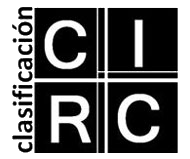The Adhesion of audiences to the new bad guys in the series
The theory of Selective Moral Disconnection as a possible explanation from the sociocognitive perspective
DOI:
https://doi.org/10.24215/16696581e900Keywords:
New bad guys, Series, Moral, Characters, Audience, Walter WhiteAbstract
The article analyzes the empathetic connection of audiences with their favorite characters in the series, in cases where the latter are complex humanized antiheroes whom we call the new bad guys of the series. The theory of selective moral disengagement is proposed, from the sociocognitive perspective, to understand the audiences exoneration for the main characters’ bad actions, through its eight mechanisms, exemplified in some moments of the serie Breaking Bad, especially the scene of the death of the character called Jane.
Downloads
References
Abi-Khalil, T.N.A. (2020). Desensitization of the Lebanese audience to the portrayal of violence on Game of Thrones and Breaking Bad: A case study. En: Journal of Media and Communication Studies. pp. 1-12 Disponible en: https://www.researchgate.net/publication/343647847_Desensitization_of_the_Lebanese_audience_to_the_portrayal_of_violence_on_Game_of_Thrones_and_Breaking_Bad_A_case_study#fullTextFileContent
American Psychological Association - APA. (2014). Manual Diagnóstico y Estadístico de los Trastornos Mentales dsm-5. (5a. ed.). Editorial Médica Panamericana
Bandura, A., Barbaranelli, C., Caprara, G.V., Pastorelli, C. (1996). Mechanisms of Moral Disengagement in the Exercise of Moral Agency. En: Journal of Personality and Social Psychology, Vol. 71, No. 2, pp: 364-374. Copyright 1996 by the American Psychological Association, Inc. Disponible en: (2) (PDF) Mechanisms of Moral Disengagement in the Exercise of Moral Agency (researchgate.net)
Bandura, A. (2001). Social Cognitive Theory: An Agentic Perspective. En: Annual Review of Psychology, Vol. 52, pp..1-26. Disponible en: https://www.annualreviews.org/doi/pdf/10.1146/annurev.psych.52.1.1
Bandura, A. (2002). Selective Moral Disengagement in the Exercise of Moral Agency. En: Journal of Moral Education, Vol. 31, No. 2. Disponible en: https://centrodocumentacion.psicosocial.net/historico/index.php?option=com_docman&view=download&alias=810-selective-moral-disengagement-in-the-exercise-of-moral-agency&category_slug=tortura&Itemid=100225
Bietti, L. M. (2009) Disonancia cognitiva: procesos cognitivos para justificar acciones inmorales. En: Ciencia Cognitiva: Revista Electrónica de Divulgación, 3:1, 15-17. Disponible en: disonancia_cognitiva-libre.pdf (d1wqtxts1xzle7.cloudfront.net)
Castro Balbuena, A. (2021). El héroe contemporáneo en la narración audiovisual. El caso de Walter White y Breaking Bad. En Tropelías. Revista de Teorìa de la Literatura y Literatura Comparada. Nro. 36. pp. 187-205. Disponible en:
https://papiro.unizar.es/ojs/index.php/tropelias/article/view/5194
Connolly, T. (2002). Breaking Bad, Dostoievsky, Nihilism, and Marketplace Morality. En: The European Legacy. Toward New Paradigms. pp. 173-185. Disponible en: https://www.tandfonline.com/doi/metrics/10.1080/10848770.2022.2129361?scroll=top
Cohen, J. (2006). Audience identification with media characters. En: Bryant, J., Vorderer, P. Psychology of Entertainment. Lawrence Erlbaum Publishers. pp. 183-197.
Cranston, B. (2017). Secuencias de una vida. Penguin Random House Grupo Editorial España.
Festinger, L. (1957). A theory of cognitive dissonance. Standford University Press
Frazer, R., Moyer-Gusé, E., Grizzard, M. (2022). Moral Disengagement Cues and Consequences for Victims in Entertainment Narratives: An Experimental Investigation. En: Media Psychology. Vol. 25, Nro. 4. pp. 619-637. Disponible en: Full article: Moral Disengagement Cues and Consequences for Victims in Entertainment Narratives: An Experimental Investigation (tandfonline.com)
Garcia Garcia, E. (2014). Neuropsicología del comportamiento moral. Neuronas Espejo, funciones ejecutivas y ética universal. En: J. De la Torre (Ed.). Neurociencia, Neuroética y Bioética. pp. 43-75. Madrid: Universidad Pontificia Comillas.
López Gutiérrez, M. y Nicolás Gavilán, M. (2015). El análisis de series de televisión: construcción de un modelo interdisciplinario. En Revista ComHumanitas, Vol. Nº 6, pp. 22-39. Disponible en: El análisis de series de televisión: construcción de un modelo interdisciplinario - Dialnet (unirioja.es)
Jost, F. (2015). Los nuevos malos. Cuando las series estadounidenses desplazan las líneas del Bien y del Mal. Libraria Ediciones.
Lyons. S. (2021). The (Anti-)Hero with a Thousand Faces: Reconstructing Villainy in The Sopranos, Breaking Bad, and Better Call Saul. En: Canadian Review of American Studies. Vol 51, Nro. 3. pp. 225-246. Disponible en: https://www.utpjournals.press/doi/full/10.3138/cras-2020-017
Marafioti, R. (2017) Narrativas seriales: participación y controles colectivos. En Revista científica de la RedCom, Año 2, Nº 4, pp. 14-24. Disponible en: Narrativas seriales: participación y controles colectivos (unlp.edu.ar)
Martínez-González, M. B., Robles-Haydar, C. A., Alfaro-Alvarez, J. (2020). Concepto de desconexión moral y sus manifestaciones contemporáneas. En: Utopía y Praxis Latinoamericana, vol. 25, Nro. 11. Universidad del Zulia. pp. 349-359. Disponible en: https://www.redalyc.org/articulo.oa?id=27964922024
Moore, C. (2015). Moral disengagement. En: Current Opinion in Psychology. Vol. 6. Nro. 10. pp. 199-204. Disponible en: moore_-_current_opinion_in_psychology_-_2015_-_moral_disengagement.pdf (celiamoore.com)
Murolo, L. (2021). Maratonear, spoilear y filtrar: el rol de las audiencias ante el audiovisual digital. En Murolo, L. y Del Pizzo, I. Cultura Pop. Prometeo. pp. 17-28.
Nieto Martínez, I. (2016). La relación equívoca entre moral y empatía (Decety, J. y Cowell, J.M.). En: The moral brain. A multidisciplinary perspective. En Aperturas Psicoanalíticas, Nº 053. Disponible en: www.aperturas.org/articulo.php?articulo=0000961
Rincón, O. (2016). Por fin triunfan los malos. La ilegalidad cool de las series de televisión. En Nueva Sociedad, Nº 263, pp. 150-159. Disponible en: 9.TC._Rincon_263.pdf (nuso.org)
Santana, M. (2016). Valores e identificación con personajes antihéroes y villanos a través del cine: El caso de Tyler Durden y el Joker. (conference paper - noviembre 2016). Disponible en: (PDF) Valores e identificación con personajes antihéroes y villanos a través del cine: El caso de Tyler Durden y el Joker (researchgate.net)
Schaefer, U., Bouwmeester, O. (2021). Reconceptualizing Moral Disengagement as a Process: Transcending Overly Liberal and Overly Conservative Practice in the Field. En: Journal of Business Ethics. pag 525 - 543. Disponible en: (PDF) Reconceptualizing Moral Disengagement as a Process: Transcending Overly Liberal and Overly Conservative Practice in the Field (researchgate.net)
Sollod, R.N., Wilson, J.P., Monte, C.F. (2009). Teorías de la Personalidad. Debajo de la máscara. McGrawHill. México.
Visa-Barbosa, M. (2011). Claves del éxito del personaje psicópata como protagonista en el cine. En Revista de Comunicación Vivat Academia, Nº 116, pp. 40-51. Disponible en: Claves del éxito del personaje psicópata como protagonista en el cine - Dialnet (unirioja.es)
Downloads
Published
How to Cite
Issue
Section
License
La aceptación de un original por parte de la revista implica la cesión no exclusiva de los derechos patrimoniales de los/as autores/as en favor del editor, quien permite la reutilización, luego de su edición (postprint), bajo una Licencia Creative Commons Atribución-NoComercial-CompartirIgual 4.0 Internacional (CC BY-NC-SA 4.0)
Acorde a estos términos, el material se puede compartir (copiar y redistribuir en cualquier medio o formato) y adaptar (remezclar, transformar y crear a partir del material otra obra), siempre que a) se cite la autoría y la fuente original de su publicación (revista y URL de la obra), b) no se use para fines comerciales y c) se mantengan los mismos términos de la licencia.
La cesión de derechos no exclusivos implica que luego de su edición (postprint) en Question las/os autoras/es pueden publicar su trabajo en cualquier idioma, medio y formato; en tales casos, se solicita que se consigne que el material fue publicado originalmente en esta revista.
Tal cesión supone, también, la autorización de los/as autores/as para que el trabajo sea cosechado por SEDICI, el repositorio institucional de la Universidad Nacional de La Plata, y sea difundido en las bases de datos que el equipo editorial considere adecuadas para incrementar la visibilidad de la publicación y de sus autores/as.
Asimismo, la revista incentiva a las/os autoras/es para que luego de su publicación en Question depositen sus producciones en otros repositorios institucionales y temáticos, bajo el principio de que ofrecer a la sociedad la producción científica y académica sin restricciones contribuye a un mayor intercambio del conocimiento global.















































